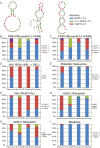Modeling RNA secondary structure folding ensembles using SHAPE mapping data
- PMID: 29177466
- PMCID: PMC5758915
- DOI: 10.1093/nar/gkx1057
Modeling RNA secondary structure folding ensembles using SHAPE mapping data
Abstract
RNA secondary structure prediction is widely used for developing hypotheses about the structures of RNA sequences, and structure can provide insight about RNA function. The accuracy of structure prediction is known to be improved using experimental mapping data that provide information about the pairing status of single nucleotides, and these data can now be acquired for whole transcriptomes using high-throughput sequencing. Prior methods for using these experimental data focused on predicting structures for sequences assuming that they populate a single structure. Most RNAs populate multiple structures, however, where the ensemble of strands populates structures with different sets of canonical base pairs. The focus on modeling single structures has been a bottleneck for accurately modeling RNA structure. In this work, we introduce Rsample, an algorithm for using experimental data to predict more than one RNA structure for sequences that populate multiple structures at equilibrium. We demonstrate, using SHAPE mapping data, that we can accurately model RNA sequences that populate multiple structures, including the relative probabilities of those structures. This program is freely available as part of the RNAstructure software package.
© The Author(s) 2017. Published by Oxford University Press on behalf of Nucleic Acids Research.
Figures



Similar articles
-
TurboFold: iterative probabilistic estimation of secondary structures for multiple RNA sequences.BMC Bioinformatics. 2011 Apr 20;12:108. doi: 10.1186/1471-2105-12-108. BMC Bioinformatics. 2011. PMID: 21507242 Free PMC article.
-
Modeling RNA Secondary Structure with Sequence Comparison and Experimental Mapping Data.Biophys J. 2017 Jul 25;113(2):330-338. doi: 10.1016/j.bpj.2017.06.039. Epub 2017 Jul 20. Biophys J. 2017. PMID: 28735622 Free PMC article.
-
Predicting RNA-RNA Interactions Using RNAstructure.Methods Mol Biol. 2016;1490:51-62. doi: 10.1007/978-1-4939-6433-8_4. Methods Mol Biol. 2016. PMID: 27665592
-
Energy-based RNA consensus secondary structure prediction in multiple sequence alignments.Methods Mol Biol. 2014;1097:125-41. doi: 10.1007/978-1-62703-709-9_7. Methods Mol Biol. 2014. PMID: 24639158 Review.
-
Predicting RNA secondary structures from sequence and probing data.Methods. 2016 Jul 1;103:86-98. doi: 10.1016/j.ymeth.2016.04.004. Epub 2016 Apr 5. Methods. 2016. PMID: 27064083 Review.
Cited by
-
Probing the dynamic RNA structurome and its functions.Nat Rev Genet. 2023 Mar;24(3):178-196. doi: 10.1038/s41576-022-00546-w. Epub 2022 Nov 8. Nat Rev Genet. 2023. PMID: 36348050 Free PMC article. Review.
-
The plant noncoding transcriptome: a versatile environmental sensor.EMBO J. 2023 Oct 16;42(20):e114400. doi: 10.15252/embj.2023114400. Epub 2023 Sep 21. EMBO J. 2023. PMID: 37735935 Free PMC article. Review.
-
Comprehensive in vivo secondary structure of the SARS-CoV-2 genome reveals novel regulatory motifs and mechanisms.Mol Cell. 2021 Feb 4;81(3):584-598.e5. doi: 10.1016/j.molcel.2020.12.041. Epub 2021 Jan 1. Mol Cell. 2021. PMID: 33444546 Free PMC article.
-
Surprising Sequence Effects on GU Closure of Symmetric 2 × 2 Nucleotide RNA Internal Loops.Biochemistry. 2018 Apr 10;57(14):2121-2131. doi: 10.1021/acs.biochem.7b01306. Epub 2018 Mar 23. Biochemistry. 2018. PMID: 29570276 Free PMC article.
-
SHAPE Probing to Screen Computationally Designed RNA.Methods Mol Biol. 2025;2847:177-191. doi: 10.1007/978-1-0716-4079-1_12. Methods Mol Biol. 2025. PMID: 39312144
References
-
- Cech T.R., Steitz J.A.. The noncoding RNA revolution-trashing old rules to forge new ones. Cell. 2014; 157:77–94. - PubMed
-
- Ban N., Nissen P., Hansen J., Moore P.B., Steitz T.A.. The complete atomic structure of the large ribosomal subunit at 2.4 Å resolution. Science. 2000; 289:905–920. - PubMed
-
- Wu L., Belasco J.G.. Let me count the ways: mechanisms of gene regulation by miRNAs and siRNAs. Mol. Cell. 2008; 29:1–7. - PubMed
-
- Matera A.G., Terns R.M., Terns M.P.. Non-coding RNAs: lessons from the small nuclear and small nucleolar RNAs. Nat. Rev. Mol. Cell Biol. 2007; 8:209–220. - PubMed
Publication types
MeSH terms
Substances
LinkOut - more resources
Full Text Sources
Other Literature Sources

